The mistake of many gardeners is growing peas without tying them to a support. This greatly reduces the yield and complicates the care of plants. Tapestries for pea beds is not difficult to do with your own hands no significant cash outlay.
Table of contents
Why do you need support for peas
Pea is a plant with a lodging stalk reaching a height of 45 cm to 250 cm. In order to fully develop and rise up to the light, the stems need to cling to the support. There are also standard types of culture that do not need support.But low-growing plants from tying only benefit.
When the pea outgrows 20-30 cm, the stems gradually begin to fall to the ground. The bushes adjacent to the ground begin to rot and become afflicted with diseases. Dampness and darkening are formed under the plants - the best conditions for snails and slugs.
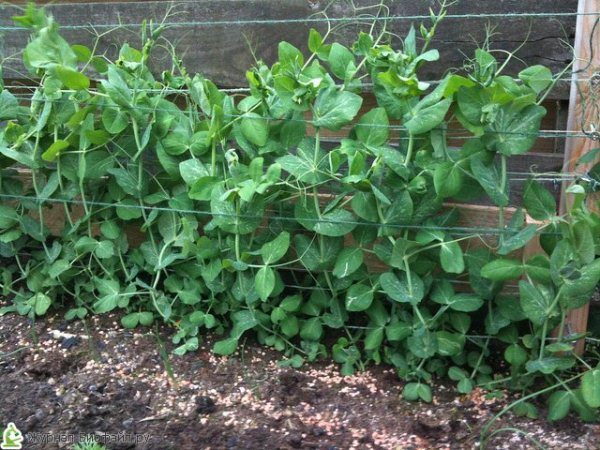
Lying green mass covers the pods. With a lack of light, the beans ripen unevenly, do not accumulate properly nutrients and sugar. Such peas lose their taste and sweetness.
It is difficult for gardeners to control pod ripening. Overripe beans take most of the plant's nutrients. Bushes begin to dry even under favorable conditions for growth.
Lying plants are difficult to spray with preventive solutions, covering all parts of the bushes. Culture is more often affected by Bruchus, who is able to destroy the entire crop. Pest-damaged beans are toxic and should not be used as food for sowing.
The advantage of supports for small gardens - vertical beds. This saves usable space. With a successful selection of support pea bed becomes an element of the decor of the site,covers unsightly buildings or fences.
How to do it yourself
There are many options for props for peas. To select the type of tapestry are guided by the features of the site, the place of the beds and the desired decoration.
It is desirable to establish a support before planting the legume, noting the place of sowing the beans. Installation work after germination can damage the roots and stems of the plant.
Support stakes
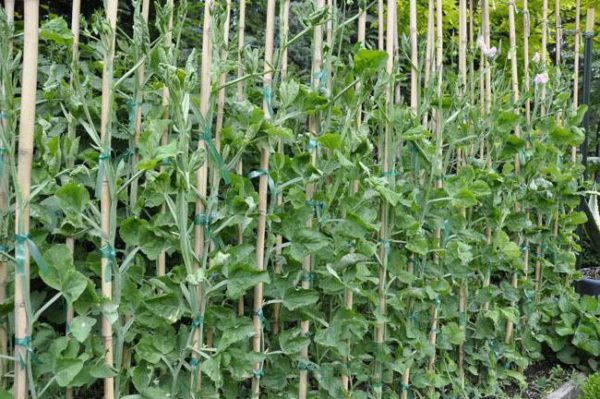
The easiest option for the garter of peas, where the role of a stand is played with stakes driven into the ground. For this purpose, reinforcing rods, wooden stakes, bamboo sticks, branches of fruit trees 1.5-2 m long are used. Stakes are buried in the ground at intervals 50 cm between two beds.
Wigwam
A good support option when you need to save space and give decorativeness to the empty space between the vegetable beds.
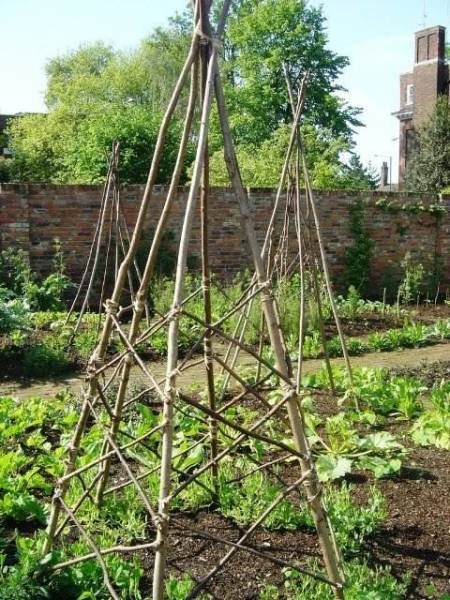
To begin with, a main pole of 2 m height is installed. Circle in the distance 0,7 m driven in poles with a slope 60° and in the upper part are fixed by knitting wire or a collar to the main pole. Peas are planted on both sides of the inclined poles.
The pallet can be made of reinforcing rods, wooden bars and tree branches. Instead of inclined poles, you can use tightly stretched wire, string or twine.
Portable trellis
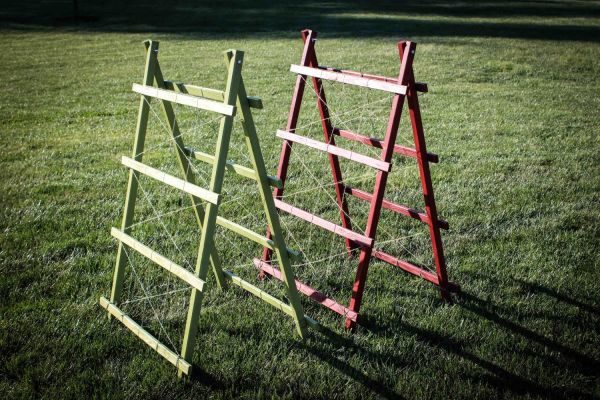
To comply with agricultural peas in one place planted only two years in a row. Therefore, gardeners have to constantly construct tapestries in a new place. This version of the trellis is mobile. It can be transferred, rotated from different angles and stored in the storage for a while.
For mounting the trellis you will need:
- three transverse timber along the length of the bed;
- two beams (1 m) for side fixings;
- four bars (1.6-2 m) for vertical posts;
- twine or cord;
- Screws and screwdriver.
Screws fasten the design basis: cross and lateral bars. To him from the outside under a slope attached vertical racks, connected at the top. Above attach another transverse beam. Twine tension every 30 cm, passing through the upper transverse beam and tying on the basis of the design.
Grid support
An easy-to-install version of the trellis is a construction with a metal net or plastic netting. It can be purchased at the building or garden store. For tying peas choose a grid width 1,6 — 2 m.
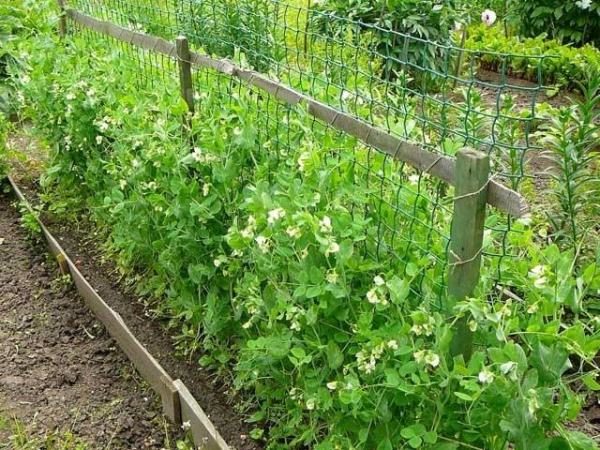
To fix the grid in the ground drive two supporting pillars. The end of the net is attached to the support pole with knitting wire or clamps. Then the roll is tensioned to the second pillar and secured in the same way. Peas are sown on both sides of the grid.
When a pea garden is planned along a fence or structure, the grid is set at an inclination 60°.Only it is important to take into account the illumination of plants, the beds should not be planned along the fence along the southern side of the site.
Bicycle rim
This is the original form of support, which will decorate the site and save usable space. For its installation you will need two bicycle rims, rebar 2.2 m long, wire and twine (cord).

Step-by-step instruction:
- form a bed 20 cm wider than the rim;
- a reinforcing bar is installed in its center;
- spokes are twisted from the rims;
- one rim is threaded through the rod and laid on the ground;
- The second rim is attached at the top of the rod with wire, passing it through the holes for the spokes;
- the cord is cut into pieces 2 times the height of the rod;
- one end of the cord is threaded into the holes of the lower rim, the other is passed through the holes of the upper rim and is tied down;
- cord permeate up to 30 holes.
Peas are sown in a circle with the outer and inner sides of the structure.
Trellis option for peas it is better to select during the planning of annual plantings. So you can maximize the decorative area and avoid unwanted proximity to other plants.
